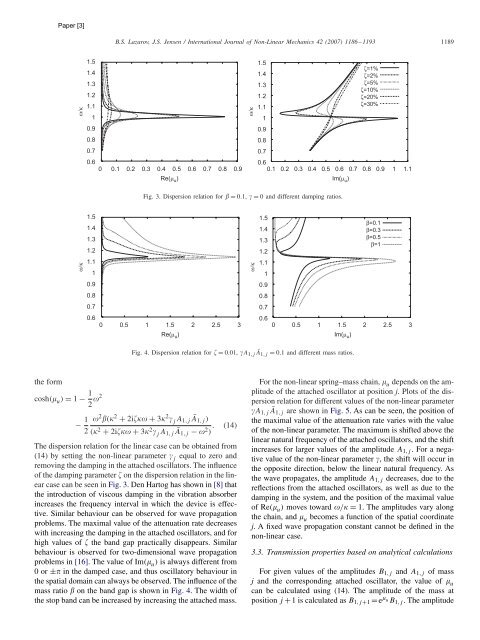WAVES AND VIBRATIONS IN INHOMOGENEOUS STRUCTURES ...
WAVES AND VIBRATIONS IN INHOMOGENEOUS STRUCTURES ...
WAVES AND VIBRATIONS IN INHOMOGENEOUS STRUCTURES ...
You also want an ePaper? Increase the reach of your titles
YUMPU automatically turns print PDFs into web optimized ePapers that Google loves.
ω/κ<br />
ω/κ<br />
1.5<br />
1.4<br />
1.3<br />
1.2<br />
1.1<br />
1<br />
0.9<br />
0.8<br />
0.7<br />
B.S. Lazarov, J.S. Jensen / International Journal of Non-Linear Mechanics 42 (2007) 1186–1193 1189<br />
ω/κ<br />
0.6<br />
0.6<br />
0 0.1 0.2 0.3 0.4 0.5 0.6 0.7 0.8 0.9 0.1 0.2 0.3 0.4 0.5 0.6 0.7 0.8 0.9 1 1.1<br />
1.5<br />
1.4<br />
1.3<br />
1.2<br />
1.1<br />
1<br />
0.9<br />
0.8<br />
0.7<br />
0.6<br />
1.5<br />
1.4<br />
1.3<br />
1.2<br />
1.1<br />
1<br />
Re(μ u ) Im(μ u )<br />
Fig. 3. Dispersion relation for = 0.1, = 0 and different damping ratios.<br />
0 0.5 1 1.5 2 2.5 3<br />
ω/κ<br />
0.9<br />
0.8<br />
0.7<br />
1.5<br />
1.4<br />
1.3<br />
1.2<br />
1.1<br />
1<br />
Re(μ u ) Im(μ u )<br />
0.9<br />
0.8<br />
0.7<br />
0.6<br />
ζ=1%<br />
ζ=2%<br />
ζ=5%<br />
ζ=10%<br />
ζ=20%<br />
ζ=30%<br />
β=0.1<br />
β=0.3<br />
β=0.5<br />
β=1<br />
0 0.5 1 1.5 2 2.5<br />
Fig. 4. Dispersion relation for = 0.01, A1,j Ā1,j = 0.1 and different mass ratios.<br />
the form<br />
cosh(u) = 1 − 1<br />
2 2<br />
− 1 <br />
2<br />
2(2 + 2i + 32j A1,j Ā1,j )<br />
(2 + 2i + 32j A1,j Ā1,j − 2 . (14)<br />
)<br />
The dispersion relation for the linear case can be obtained from<br />
(14) by setting the non-linear parameter j equal to zero and<br />
removing the damping in the attached oscillators. The influence<br />
of the damping parameter on the dispersion relation in the linear<br />
case can be seen in Fig. 3. Den Hartog has shown in [8] that<br />
the introduction of viscous damping in the vibration absorber<br />
increases the frequency interval in which the device is effective.<br />
Similar behaviour can be observed for wave propagation<br />
problems. The maximal value of the attenuation rate decreases<br />
with increasing the damping in the attached oscillators, and for<br />
high values of the band gap practically disappears. Similar<br />
behaviour is observed for two-dimensional wave propagation<br />
problems in [16]. The value of Im(u) is always different from<br />
0or± in the damped case, and thus oscillatory behaviour in<br />
the spatial domain can always be observed. The influence of the<br />
mass ratio on the band gap is shown in Fig. 4. The width of<br />
the stop band can be increased by increasing the attached mass.<br />
For the non-linear spring–mass chain, u depends on the amplitude<br />
of the attached oscillator at position j. Plots of the dispersion<br />
relation for different values of the non-linear parameter<br />
A1,j Ā1,j are shown in Fig. 5. As can be seen, the position of<br />
the maximal value of the attenuation rate varies with the value<br />
of the non-linear parameter. The maximum is shifted above the<br />
linear natural frequency of the attached oscillators, and the shift<br />
increases for larger values of the amplitude A1,j .Foranegative<br />
value of the non-linear parameter , the shift will occur in<br />
the opposite direction, below the linear natural frequency. As<br />
the wave propagates, the amplitude A1,j decreases, due to the<br />
reflections from the attached oscillators, as well as due to the<br />
damping in the system, and the position of the maximal value<br />
of Re( u) moves toward / = 1. The amplitudes vary along<br />
the chain, and u becomes a function of the spatial coordinate<br />
j. A fixed wave propagation constant cannot be defined in the<br />
non-linear case.<br />
3.3. Transmission properties based on analytical calculations<br />
For given values of the amplitudes B1,j and A1,j of mass<br />
j and the corresponding attached oscillator, the value of u<br />
can be calculated using (14). The amplitude of the mass at<br />
position j +1 is calculated as B1,j+1 =e uB1,j . The amplitude<br />
3

















